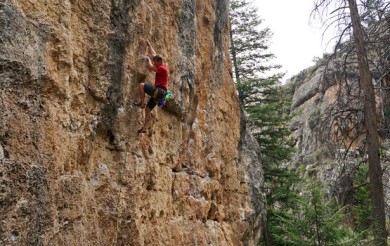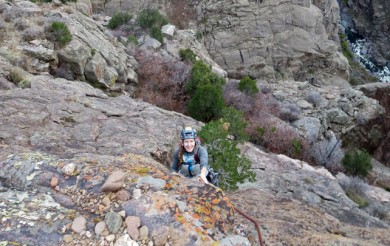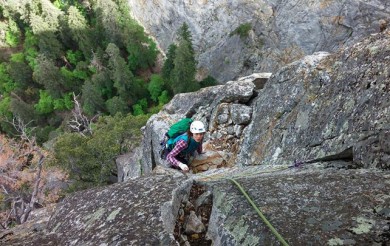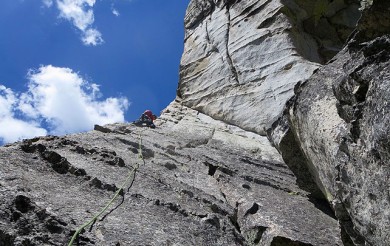The Science of Climbing’s Awesomeness
Guest post by Tristan Higbee.
“Tristan, it’s all about flow! I can totally understand now why you climb!” I doubted this very much. These words were coming from my next door neighbor, who has gone climbing all of two or three times in her life. She had, however, studied something called “recreational management and youth leadership” in college, which made her an expert in playing around outside and not having a job (something I also managed to do as a linguistics student.) Anyway, she had read about something called flow theory in one of her classes, and went on to explain it to me. And I have to admit, I was pretty intrigued.
Flow theory is “is the mental state of operation in which a person in an activity is fully immersed in a feeling of energized focus, full involvement, and success in the process of the activity… The hallmark of flow is a feeling of spontaneous joy, even rapture, while performing a task” (thanks, Wikipedia). That definition is important, so read it again. I guess it’s what surfers refer to it as stoke. To the ball sport people, it’s keeping your head in the game, or being in the zone. What do we call it in climbing? And more important than the label we attach to it is why we feel it. In other words, what is it about climbing that makes it so addicting, fulfilling, and all-around awesome?
Below are the ten factors that accompany an experience of flow, also quoted from Wikipedia. They’re interspersed with my comments about how they relate to climbing:
1. Clear goals (expectations and rules are discernible and goals are attainable and align appropriately with one’s skill set and abilities). Moreover, the challenge level and skill level should both be high.
Whether we think about it or not, climbing is pretty goal oriented. Don’t fall. Don’t hang on the rope. Get to the top of the cliff. Don’t die. And I think the challenges and skill sets involved in climbing are obvious to us all.
2. Concentrating, a high degree of concentration on a limited field of attention (a person engaged in the activity will have the opportunity to focus and to delve deeply into it).
The focus required while climbing is tremendous. We’ve got to figure out where to go, where to place gear, what gear to place. We’ve got to keep our leg behind the rope, have got to manage rope drag, and communicate with belayers. We’ve got to do all of this while hanging on the side of a friggin’ mountain by our toes and finger tips. Now THAT is concentration.
3. A loss of the feeling of self-consciousness, the merging of action and awareness.
A lot of the things we do while climbing are automatic. When you hear the sound of rockfall, you immediately take cover. If you’re an experienced trad climber, you know that the bomber tight hand jam you’ve got is perfect red Camalot size, and you reach down, grab, and plug without thinking twice about it. You are aware, and you take the necessary action. The mechanics of climbing become automatic. They become a reaction more than a decision.
4. Distorted sense of time, one’s subjective experience of time is altered.
Huh? It’s getting dark already? Damn… “Hey man, did you bring your headlamp?”
5. Direct and immediate feedback (successes and failures in the course of the activity are apparent, so that behavior can be adjusted as needed).
You fail if you find yourself dangling upside down with your head broken. There’s a clear line in every climber’s mind that delineates success and failure, though I’d say that the definition of success and failure is different for every climber.
6. Balance between ability level and challenge (the activity is neither too easy nor too difficult).
This of course depends on what particular route we’re on, but it’s something that is definitely entirely within our control. Obviously a 5.2 will challenge the average climber less than a 5.13. But I’d say that most of us usually climb things that we find challenging, things that we can’t just waltz up, but that are attainable.
7. A sense of personal control over the situation or activity.
This is one thing that I love about climbing. Whether I succeed or fail, and whether I climb a route or not, is usually all up to me. I can’t blame it on a teammate. If I’ve been training and climbing well and if I get a good night’s sleep, eat a good breakfast, and warm up before a project, the odds are good that I’ll send the thing. Even with something I can’t control like weather, I can control whether I go out or not, or I can choose to go somewhere else with better weather.
8. The activity is intrinsically rewarding, so there is an effortlessness of action.
Unfortunately, we get no monetary reward or fame from climbing. The reward comes in the physical and mental exercise that we enjoy. The reward comes from sharing intense experiences with friends. The reward comes from experiencing some of the world’s most awe-inspiring places.
9. A lack of awareness of bodily needs (to the extent that one can reach a point of great hunger or fatigue without realizing it)
I laughed when I read this one. I rarely eat when I’m on a long climb. I don’t know if it’s a straight up loss of appetite or whether I’d rather just spend that time climbing. It’s usually not until the descent that I realize how hungry I am and that I probably should have been snacking at the belays. And how many times do I end up absolutely exhausted after 14 hours of staying inside and doing nothing, yet I can be constantly moving in a harsh mountain environment for 20 hours.
10. People become absorbed in their activity and focus of awareness is narrowed down to the activity itself.
When you’re climbing, you’re not thinking about much else. You’re not thinking about that stupid jackace who rear ended your car the other day. You’re thinking that if this hand hold breaks, you’re going to be screwed. Or you’re thinking about how lucky you are to be a climber.
I don’t know about you, but all of that sounds awfully familiar to me. One other thing that my friend told me is that people experiencing flow don’t necessarily experience all of the ten above-mentioned factors. The thing is, though, I DO experience all ten of those when climbing! Maybe that’s why climbing is so freaking awesome. It scores a perfect ten on the flow-o-meter. But hey, at the end of the day, the only thing that really matters is that we enjoy it. The reasons why are secondary, and figuring them out is just another rewarding aspect of this wonderful sport of ours.
Tristan Higbee can often be found creating new routes when he’s not busy writing his Daily Climbing Tips blog.
One Response to The Science of Climbing’s Awesomeness
Bulldog Creek Dog Walk (IV WI 4+)
Hayden Carpenter and Tom Bohanon recently repeated an obscure ice climb on the south side of Mt Sopris. Given a brief mention in Jack Robert’s ice guide, Bulldog Creek Walk is described as being 100 meters of WI 4. What they found was seven pitches of ice in a remote setting that makes for one […]
Connect with Us















Don’t forget about the sociology/psychology of “edgework”. If you are into reading about your personal driving force, consider googling the term. There is even some interesteding books on the topic, describing in detail the forces that drive some to move to the edge of their abilities.